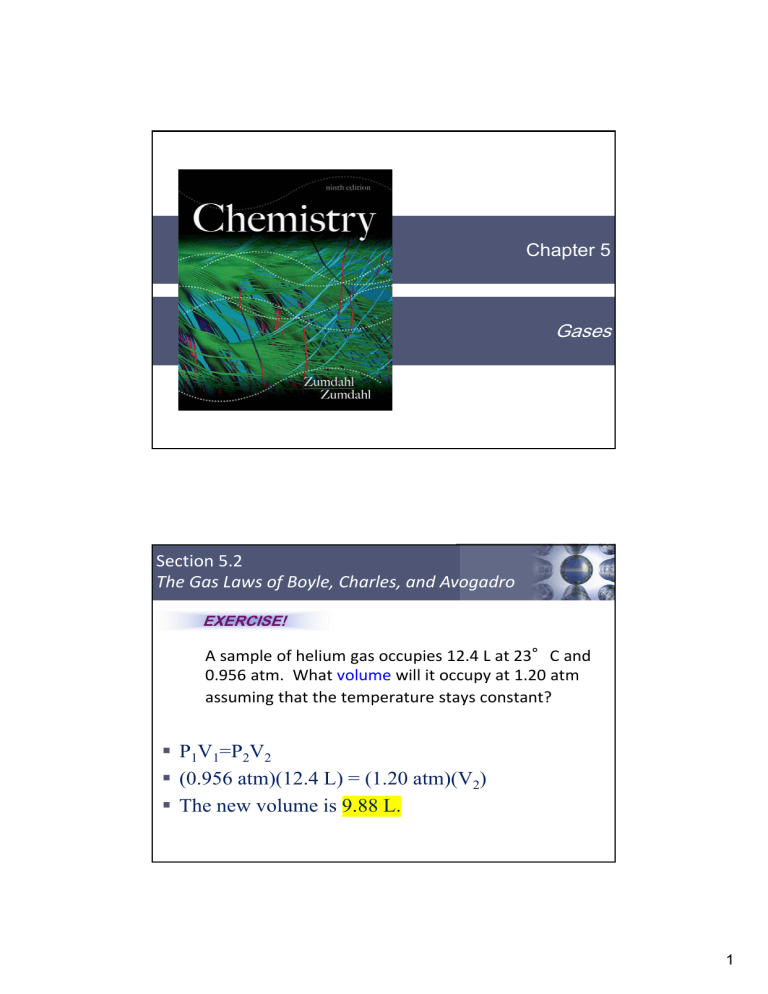
Chapter 5
Gases
Section 5.2
The Gas Laws of Boyle, Charles, and Avogadro
EXERCISE!
A sample of helium gas occupies 12.4 L at 23°C and 0.956 atm. What volume will it occupy at 1.20 atm assuming that the temperature stays constant?
P1V1=P2V2
(0.956 atm)(12.4 L) = (1.20 atm)(V2)
The new volume is 9.88 L.
Copyright © Cengage Learning. All rights reserved
2
1
Section 5.2
The Gas Laws of Boyle, Charles, and Avogadro
EXERCISE!
Suppose a balloon containing 1.30 L of air at 24.7°C is placed into a beaker containing liquid nitrogen at –78.5°C. What will the volume of the sample of air become (at constant pressure)? V1/T1 =V2/T2
Remember to convert the temperatures to Kelvin.
(1.30 L) / (24.7+273) = V2 / (-78.5 + 273)
0.849 L
Copyright © Cengage Learning. All rights reserved
3
Section 5.2
The Gas Laws of Boyle, Charles, and Avogadro
EXERCISE!
If 2.45 mol of argon gas occupies a volume of 89.0 L, what volume will 2.10 mol of argon occupy under
the same conditions of temperature and pressure?
n1/v1 = n2/v2
The new volume is 76.3 L.
(2.45 mol) / (89.0 L) = (2.10 mol) / (V2)
76.3 L
Copyright © Cengage Learning. All rights reserved
4
2
Section 5.3
The Ideal Gas Law
EXERCISE!
An automobile tire at 23°C with an internal volume of 25.0 L is filled with air to a total pressure of 3.18 atm. Determine the number of moles of air in the tire. PV= nRT
The number of moles of air is 3.27 mol.
(3.18 atm)(25.0 L) = n(0.08206)(23+273)
3.27 mol
Copyright © Cengage Learning. All rights reserved
5
Section 5.3
The Ideal Gas Law
EXERCISE!
What is the pressure in a 304.0 L tank that contains 5.670 kg of helium at 25°C? n(moles) = mass/Molar mass
PV= nRT or PV = ([mass(g)x 1000] /Molar mass). R T
Remember to convert kg of helium into moles of helium
before using the ideal gas law.
(P)(304.0) = ([5.670×1000]/4.003)(0.0821)(25+273)
114 atm
Copyright © Cengage Learning. All rights reserved
6
3
Section 5.3
The Ideal Gas Law
EXERCISE!
7
Section 5.4
Gas Stoichiometry
EXERCISE!
A sample of oxygen gas has a volume of 2.50 L at 0°C and 1 atm pressure. How many grams of O2 are present? PV=nRT
(1.00 atm)(2.50 L) = n(0.08206)(273)
n= 0.112 moles of O2
Mass = n x molar mass,
= 0.112 mol O2 × 32.00 g/mol = 3.57 g O2
3.57 g
Copyright © Cengage Learning. All rights reserved
8
4
Section 5.4
Gas Stoichiometry
EXERCISE!
What is the density of F2 at STP (in g/L)?
d = (Molar Mass)(P) / (R)(T)
d = (19.00g/mol × 2)(1.00 atm) / (0.08206)(273 K)
d = 1.70 g/L
1.70 g/L
Copyright © Cengage Learning. All rights reserved
9
Section 5.5
Dalton’s Law of Partial Pressures
EXERCISE!
Consider the following apparatus containing helium in both sides at 45°C. Initially the valve is closed.
After the valve is opened, what is the pressure of the helium gas? 2.00 atm
9.00 L
Copyright © Cengage Learning. All rights reserved
3.00 atm
3.00 L
10
5
Section 5.5
Dalton’s Law of Partial Pressures
Solution
Find the new pressure of the gas on the left side after the
valve is opened (P1V1=P2V2). The pressure becomes 1.50
atm.
(2.00 atm)(9.00 L) = (P2)(9.00 L + 3.00 L)
P2 = 1.50 atm
Find the new pressure of the gas on the right side after the
valve is opened (P1V1=P2V2). The pressure becomes 0.75
atm.
(3.00 atm)(3.00 L) = (P2)(9.00 L + 3.00 L)
P2 = 0.75 atm
The total pressure is therefore 1.50 + 0.75 = 2.25 atm.
Section 5.5
Dalton’s Law of Partial Pressures
EXERCISE!
27.4 L of oxygen gas at 25.0°C and 1.30 atm, and 8.50 L of helium gas at 25.0°C and 2.00 atm were pumped into a tank with a volume of 5.81 L at 25°C.
Calculate the new partial pressure of oxygen.
6.13 atm
Calculate the new partial pressure of helium.
2.93 atm
Calculate the new total pressure of both gases. 9.06 atm
Copyright © Cengage Learning. All rights reserved
12
6
Section 5.5
Dalton’s Law of Partial Pressures
Solution
For oxygen:
P1V1=P2V2
(1.30 atm)(27.4 L) = (P2)(5.81 L)
P2 = 6.13 atm
For helium:
P1V1=P2V2
(2.00 atm)(8.50 L) = (P2)(5.81 L)
P2 = 2.93 atm
The total pressure is therefore 6.13 + 2.93 = 9.06 atm.
Section 5.6
The Kinetic Molecular Theory of Gases
CONCEPT CHECK!
• You have a sample of nitrogen gas (N2) in a container fitted with a piston that maintains a pressure of 6.00 atm. Initially, the gas is at 45°C in a volume of 6.00 L.
• You then cool the gas sample.
Copyright © Cengage Learning. All rights reserved
14
7
Section 5.6
The Kinetic Molecular Theory of Gases
CONCEPT CHECK!
Which best explains the final result that occurs once the gas sample has cooled?
a)
b)
c)
d)
e)
The pressure of the gas increases.
The volume of the gas increases.
The pressure of the gas decreases.
The volume of the gas decreases.
Both volume and pressure change.
Copyright © Cengage Learning. All rights reserved
15
Section 5.6
The Kinetic Molecular Theory of Gases
CONCEPT CHECK!
The gas sample is then cooled to a temperature of 15°C. Solve for the new condition. (Hint: A moveable piston keeps the pressure constant overall, so what condition will change?)
Charles’s law to solve for the new volume).
(6.00 L) / (45+273) = (V2) / (15+273)
5.43 L
Copyright © Cengage Learning. All rights reserved
16
8
